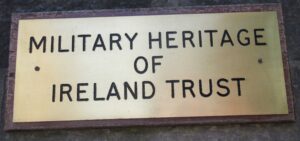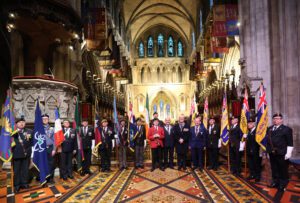Irish Aces of the RFC and RAF – WW1 – “The Lives Behind the Legends” – Joe Gleeson
The First World War had an enormous impact on Ireland. The Irish contribution to the air war remains overlooked, not just in Ireland, but also by historians generally. Although just 6,000 Irish served with the Allied flying services at a cost of 500 casualties, their impact was out of all proportion to their numbers.
The contribution of Irish aces of the Royal Flying Corps and the Royal Air Force to the Allied cause was significant, just over 30 of whom accounted for 400 enemy aircraft. Irishmen were among the highest-scoring pilots of the war.
Brigadier-General Paul Fry, GOC Air Corps reviews Joe Gleeson’s book published by Fonthill Media (October 2015). The review highlights the valour of Irish aviators such as Sgt J.J. Cowell MM DCM from Limerick, 2Lt Giles Noble Blennerhassett MM from Sligo, Lt Harry George Crowe MM OBE from Donnybrook, and Major T.F. Hazell MC DSO DFC and Bar from Newport Co Mayo.
 “I jumped at the chance to read this book, brought up as I was on a restricted diet of WW1 aces such as Mannock (61 victories, and in this book) and Ball (44 victories) on the Allied side and Germany offering the Baron von Richtoffen (80 victories) and Boelke (40 victories). France featured too with Rene Fonck (75 victories and leading Allied aces of that conflict) and Charles Nungesser (21 victories) (and can I recall a Turkish or Russian ace at all? There surely must have been some? Room for another tome there too by the look of it!!”
“I jumped at the chance to read this book, brought up as I was on a restricted diet of WW1 aces such as Mannock (61 victories, and in this book) and Ball (44 victories) on the Allied side and Germany offering the Baron von Richtoffen (80 victories) and Boelke (40 victories). France featured too with Rene Fonck (75 victories and leading Allied aces of that conflict) and Charles Nungesser (21 victories) (and can I recall a Turkish or Russian ace at all? There surely must have been some? Room for another tome there too by the look of it!!”
“A hard copy was sent to me – a fine production, I like hardcopy for its enduring permanence with attractive cover sleeve art work and inside many interesting pictures. I must confess that I would be happier if there were more pictures as these are becoming more available now and they surely would add to the overall content in a positive way. I do like the chapter layout, it is well structured and appealing, each ‘ace’ story starting with brief details of personal life and history complimented with awards listings and number of ‘kills’ which all goes to set the stage nicely for each chapter. I have to admit that when I got to reading it I couldn’t put it down!!”
“Content lives up to the high print quality and production. A gripping, well researched volume of details and a well interpreted analysis of what the aces themselves were like, their families and upbringing, school life and education and early military service. I found it curious to read of their upbringing and see various Irish family backgrounds and locations mentioned where they grew up and were educated in Ireland. This is really what sets this book apart and adds greatly to its captivating interest.”
“We all probably associate aces with single seat aircraft pilots but another aspect of these aces – and one which I had never considered before – was the number of Observer/Air Gunners classified as aces, i.e. more than five ‘victories’. These airmen crewed missions with a variety of pilots – probably having wide and varying piloting skills sets – yet managed to dispose of several enemy aircraft through accurate deflection shooting while their own craft was taking evasive action! A remarkable feat and the ‘kill’ was credited to the gunner, not the pilot. Remarkable amongst these for example was Sgt J.J. Cowell, a Limerick man, who scored fifteen ‘victories’ as an air gunner and one following completion of his pilot training. He was awarded the Military Medal twice as well as the Distinguished Conduct Medal (DCM). Another of note was 2Lt Giles Noble Blennerhassett, a native of Sligo, he accumulated eight ‘victories’ and the Military Medal then like Cowell trained as a pilot serving in Home Defence Fighter Units to counter German bomber raids on London towards the end of the war. Following the Armistice he was posted to 11th (Irish) Group based at Baldonnel in 1919.”
“Few of the aces survived the war to reach to old age but those that did have their post-War lives traced out in satisfying detail. A few even served in the Second World War, some even being highly decorated, one amongst them Lt. Harry George Crowe from Simmonscourt, Donnybrook, Dublin. Enlisting in the Royal Irish Regiment he saw action in Kemmel, on the Somme front then at the Battle of Messines before, having survived a year in combat at a time when Infantry Officers lives were measured in days, he was accepted as an Air Gunner subsequently being credited with eight victories and winning the Military Medal. He qualified as a pilot but graduated just as the war ended. Following the conflict he was posted to RAF Collinstown, in 11 (Irish) Group, moving to RAF Baldonnel then Fermoy. He also saw service abroad after this posting in RAF HQ Baghdad, Amman in Jordan and also in Malta. Following his service as Air Group Commander (India) in World War Two he was decorated with the OBE in 1944 and the Cloud and Banner Decoration with Special Cravat by the Peoples Republic of China in 1946. A remarkable career and span of service!”
“One name that caught my eye – other than that of Oscar Heron, late of the Air Corps – was that of Major T.F. Hazell, Military Cross, Distinguished Service Order, and Distinguished Flying Cross and Bar. This Officers name, previously unknown to me, crossed my desk in the last two years by way of the discovery of his badly neglected grave in Newport, Co. Mayo. Hazell was an accomplished air fighter with 46 kills to his name. His burial in Newport is appropriate due to an aircraft type of that name – the Nieuport Scout – being his favourite fighting aircraft. His grave has now been restored. As next year is the one hundredth anniversary of the award of his pilots “Wings”, on 6 June 1916, there might even be a celebration of his outstanding war service in Mayo.”
“If you have an interest in early combat aviation, if you are an avid reader of World War One, if you are an Irish military researcher or historian then I cannot recommend this highly book enough. It is a tour de force, opening up an intriguing and previously unrecorded aspect of the Irish engagement in World War One. It certainly has a place in the context of the Decade of Commemoration, marking as it does an alternative aspect to early Twentieth Century Irish fighting spirit and military service.”





